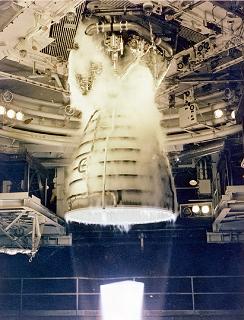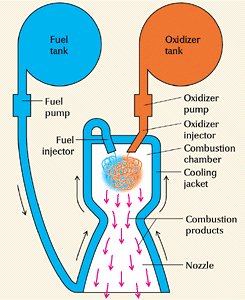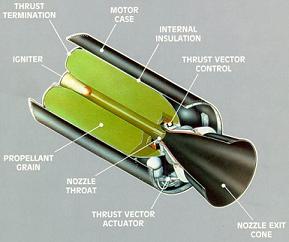
Home
Rocketry
History
Rocket Equation
Propulsion
Build Your Own
Orbits
Technology
Propulsion

A propellant is a mixture that is burned to create thrust. A typical propellant is made of a fuel and an oxidizer. The fuel burns in the presence of oxygen, and the oxidizer provides the oxygen to burn. A propellant is measured by its gas velocity, or its specific impulse. These values have a simple relation and are characteristic of the propellant. There are a few basic types of propellants liquid, solid, hybrid and exotic. Exotic being ion-propulsion, nuclear propulsion and anything that belongs in a science fiction book, hybrid fuels are simply a mix of solid and liquid rocket propellants.

Liquid propellants have evolved from the early days of petroleum based propellants up to the cryogenic ones used today. Very early rockets used ethanol as a fuel, and as rockets evolved kerosene became popular. The type of kerosene used was a highly purified one, called RP-1. RP-1 was the fuel on Saturn V. The advantages of these fuels are they are relatively easy to store and make, but they are harmful heavy and have a lower gas velocity compared to cryogenic fuels. Typically cryogenic propellants are liquid oxygen (LOX) as the oxidizer and liquid hydrogen as the fuel, this has a very high gas velocity. The disadvantages are they are very hard to store, since they have to be kept at -250oC, and since they are so light they take up a large volume and require large and heavy tanks. One special class of fuels are hypergolic fuels. These spontaneously ignite when the fuel and oxidizer come into contact. They are liquid at room temperature so are easier to store than cryogenic propellants. Hypergolic propellants are used mainly in the reaction control systems, like on the space shuttle, and are usually made from hydrazine. Hypergolic fuels are toxic and very dangerous to handle.

Solid propellants are dense and easily storable, they are found as either homogeneous or composite materials. Solid propellants are mostly used to give an extra boost, either on launch vehicles or attached to satellites to insert them into the desired orbit. Solid rocket fuels are a mixture of complex molecules, the oxidizer is mixed with the fuel, as opposed to liquid fuels where they are separate. The actual composition is not important here. The important part is that they are very simple to manufacture and store, and require nothing special in terms of the engine. The propellant is simply ignited and it will then continue to burn from the inside out, till there is nothing left. This is a major advantage over liquid fuels which require very complicated engines with turbo pumps and specific mixtures combined in a chamber separate from the storage chambers. The benefit of liquid propellant engines is that they can be throttled stopped and restarted.